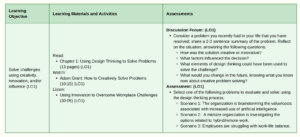
Analyze
Review the LOs for your identified course and begin developing assessments that align with those LOs. Alignment is critical to ensuring the success of the students and the course.
Assessment vs. Assignment
In some cases you may notice assessment used instead of assignment. There are key differences between these two terms. Learn more about their differences below:
- An assessment refers to the process by which an instructor evaluates the learner’s knowledge against the learning objectives. An assessment is often an interactive process the focuses on both teaching and learning. Formative and summative assessments are the two main types of assessments; summative is generally at the end of a unit or course (example: midterm and final exams). Where formative evaluations are throughout the learning process to check in on progress and provide feedback.
- An assignment tends to refer to a learning activity that is primarily intended to foster or consolidate learning, such as a discussion forum.
Learn more about Types of Assignments and Assessments with this resource from University of Waterloo.

Whenever possible, consider open pedagogy as an assessment strategy to build real-world relevance into the course.
Open pedagogy is an instructional strategy for building public-facing assessments that are relevant to the community, be it locally or globally. Open pedagogy offers students a tangible way to connect what they are learning in class to real-world examples, which can stimulate interest, motivate students, and engage them in more critical thinking opportunities.
Here are some examples of assessments that would align with different levels of Bloom’s taxonomy.
| Assessment | Bloom’s Alignment |
| Create a how-to guide to recycling for the community. | Create, Design, Develop, Author |
| Prepare a guide for learning a shop local campaign. | Construct, Create, Organize, Develop |
| Demonstrate how to make a budget in a 5-7 minute video. | Solve, Demonstrate, Design |
| Evaluate the case details to prepare a meal plan assessment and options. | Compare, Examine, Solve, Interpret, Recognize |
| Generate study resources for the next generation of students. | Classify, Identify, Explain, Locate, Recognize |
Research
After the learning outcomes and assessments have been determined and aligned, it is time to select learning materials. There are three ways to locate openly licensed or open-sourced content.
Library
The first and likely best place to start is at your institution’s library. The library website or on-the-ground librarians can help you locate openly sourced content and often have LibGuide with information about OER and OER repositories. Moreover, even if the content is not open-sourced or OER, the library has countless items available for use in courses. So, regardless: start there.

If you are on a library website here are some steps to locating the Open Source filters. Begin your search with relevant search terms and then filter by content type, selecting “Open Access”. This will eliminate resources that are not open. The library may also have items within their collection you can use which are available to the user via subscription. These are great resources as well, but would not likely be considered open resources, because there is a fee associated. This may or may not matter, depending on the institution and relevant course marking procedures.
Advanced Search in Google
Google offers a feature for filtering your results so only OER will appear. Follow the directions below to filter your Google search results.

Please note: the filter will not remain after the window is closed nor transfer to other tabs. You will have to reset the filter with each new search or tab.
- Navigate to Google.
- In the lower right corner, select Settings.
- From the menu select Advanced Search.
- Enter key words.
- Locate the usage rights menu at the bottom of the page.
- Select free to use, share, or modify, even commercially. This is the most open option for results.
- Select Advanced Search button.
OER Repositories

The last way to find open content is to go to the large repositories available around the world. While this will likely take longer to parse through, this can still be an effective way to find resources. Remember: OER can be adapted to fit your needs and/or created where there are gaps! You may also want to connect with a librarian to help you with this if you are unfamiliar.
Here are some of the most commonly used options, but by no means is this an exhaustive list.
Alignment: The Remix
Alignment between the learning objectives, learning materials/activities, and assessments is critical. This demonstrates to the students that the work they are doing is relevant to the course and will ensure their mastery of the learning outcomes. There are many ways to organize items into a cohesive format to verify learning outcomes. One strategy is to use a course map. Review the example below to understand alignment better.

Quiz #4
Purpose: The quiz reviews elements of alignment, which is an important component of course design. It has a combination of multi-select and multiple choice questions. Please try to achieve at least an 80% score.

